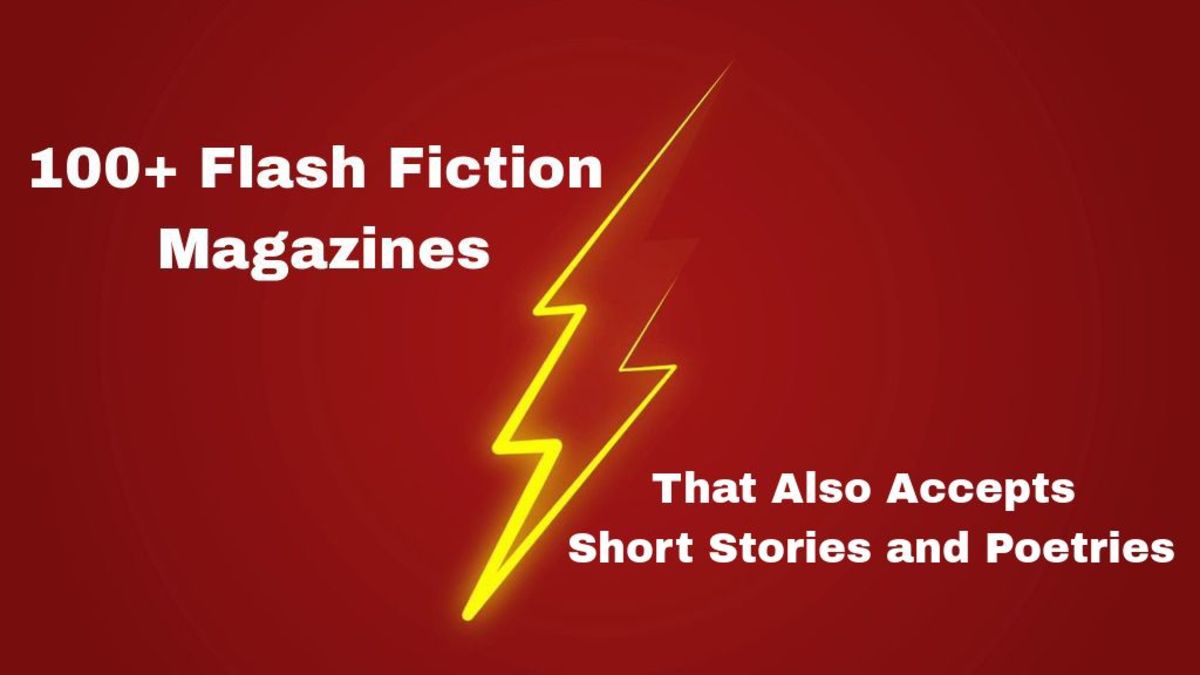- HubPages»
- Books, Literature, and Writing»
- Commercial & Creative Writing»
- Creative Writing
Flash Fiction: A Writer’s Guide
What's Your Experience?
Do you regularly write stories or articles that have a specific word limit?
A Definition of Flash Fiction
Short stories have always been popular with publishers. In today’s information age, flash fiction is growing in popularity. For decades, people who don’t want to commit to reading a lengthy novel have paused long enough to read an engaging short story. Flash fiction, loosely defined as a short story less than 1,000 words in length, provides a unique form of literary entertainment while at the same time accommodating modern readers with busy schedules and short attention spans. This form of prose is particularly popular with internet users, and several writers’ groups across the web regularly host flash fiction challenges.
Various flash fiction challenges have various rules. One extreme challenge, inspired by a story credited to Ernest Hemmingway, urges writers to submit a six-word story once a month. Several photo-prompt challenges encourage writers to compose flash fiction in response to a specific photo. These challenges have a variety of word limits. A weekly challenge in which I participate sets the word limit at 100 words. Others fall between 300 and 600 words. A challenge in which I participate on LinkedIn sets the limit at 4,000 characters, the space allowed by the website’s interface. All of these challenges and contests have one factor in common—each flash should be a complete story with a beginning, middle and end. In getting to the end, many writers struggle to adhere to word constraints. With proper editing and some discipline, however, writers can succeed in writing complete, well-crafted stories regardless of the constraints.
Many regular flash fiction challenges are based on photo prompts.

Accommodating the Word Limit
A common complaint among those new to writing flash fiction is the word-count constraint. Although fiction prose writers may not be familiar with such constraints, most any writing has to meet some word count or other. Journalists are limited by the space available in a newspaper column or the pages allotted for a magazine article. In school, aspiring writers are limited by the paper length set by an instructor. Fitting an intriguing story into the allotted number of words for a flash fiction makes use of many of the same skills used by students and journalists.
What 100-word story would you write given this photo prompt?

Pick a Manageable Topic
The first thing to consider when grappling with tight word constraints is the topic of your story. You need to choose a story that can be told completely in the specified number of words. For example, the stories you can tell in 600 words will be different from the stories you can tell in a novel, and a 600-word story can effectively cover topics that can’t be handled in a mere 100 words. Flash fiction writers don’t need to avoid complex topics, but you should recognize that extremely short stories aren’t the place for addressing multiple nuances and varying viewpoints. Flash fiction simply isn’t roomy enough. Instead, flash fiction writers need to pick a point of view and focus tightly on making a single point.
Almost any flash fiction story could be expanded into a longer story. Some would even make great novels. I often sketch out backgrounds and story details that will never be revealed in my flash fiction. Other times I include details that get cut before the final edit. What makes a flash fiction story great is the ability of the author to focus it tightly and drive home a single point. Like a journalist, the flash writer needs to prioritize details, with the understanding that the less important details may be cut. The inclusion of side stories or interesting details works in a novel and stories more than 1,000 words in length, but in a flash fiction, adding too many details or side notes weakens the flash by drawing the reader’s attention away from the point of the story.
Quick Tips
- Pick a manageable topic.
- Stay focused.
- Cut unnecessary descriptors.
- Trust your reader.
Write a First Draft
First drafts of flash fiction are often double the length that they will be at the end of the editing process. Every experienced writer understands the importance of getting words onto paper or computer screen. Once you’ve chosen a topic and a focus for your story, get it down. Don’t worry at first if your story runs long. Just write it, but resist the urge to go into detail about the appearance of your characters or the scenery. In flash fiction, you need to rely on your reader’s imagination to fill in those details while you supply the cues with a tightly composed story focused on the point you’ve chosen. Get the story onto your computer screen, but make sure to keep your focus as you write.
Flash fiction stories should have a single purpose and direct focus.

Choose What Cuts to Make
Editing your own work can be a daunting task, but it’s perhaps more important for flash fiction writers than for writers of any other genre. In your first draft, you undoubtedly included some fluff that can be cut without harming the story. Sometimes this means that you lose entire paragraphs describing background information that isn’t necessary for making your point or moving the action along. Many times, writers will make cuts to eliminate a secondary plot that doesn’t fit the flash format. After making those big cuts, however, you might still find that your 700-word story needs to be cut by 100 words or your 100-word story needs to be cut by 15 words. This is when the painful cuts need to take place.
In many online challenges and flash-fiction forums, the writers who complain most vocally about the word constraints are the ones least skilled or least willing to become skilled in cutting excess modifiers that would be perfectly okay in a novel but simply don’t fit and aren’t necessary in flash fiction. In a 100-word story, the phrase “of course” can almost always be omitted to accommodate the word count and strengthen the story. Avoid the temptation to fall in love with a particular turn of phrase, especially if you can clearly see a shorter way of saying the same thing. In order to trim a story by about 10 percent without losing any of the plot, take a look at every modifier. Do you need to give the color of your character’s shoes in a story about a carnival? Are all of your prepositional phrases focused on the point of your story? If the answer is “no,” you have found words to cut. By cutting unnecessary descriptors, you can avoid cutting vital information from your story in an effort to accommodate the word constraints.
Inspiration for flash fiction can be found everywhere.

Improve Your Stories
Trust Your Readers
As a writer, it’s easy to become a control freak. We want our readers to envision our characters and settings in the same way that we envision them. However, unless the point of your flash fiction is that people with blue eyes always act a certain way, no reader is going to notice that you left out your character’s eye color. In fact, without all those details provided in the text, your readers will be free to use their own imagination to conjure up characters that fit their realities. In turn, your story becomes more universal.
This can be a scary prospect. I once posted a 100-word flash about an artist whom I considered a villain, but because the story was so short, I chose to cut the details that painted him as either good or bad. The resulting story led several readers to draw differing conclusions. Some even recommended that he strike up a romantic relationship with my heroine. Since the point of my story had nothing to do with a budding romance or the virtue of either character, it didn’t matter what people thought about those things. All of my readers had a fulfilling experience by reading the story and drawing their own conclusions, and I read their comments without revealing what I thought of the characters. While my point of view was valid, the reader responses were just as valid. For me, one of the most satisfying aspects of composing flash fiction is the way that different readers come away with different understandings, depending on their personal perspectives. No reader is wrong, and every reader’s response enriches the creative experience.
Other Tips for Flash Fiction
In a 1,500-word article, I don’t have space to discuss all the elements of quality flash fiction. Strong nouns and verbs are great ways to add more punch to flash fiction. Active voice will help to engage readers also, so steer away from the verb “to be” and add action words whenever possible. If you are fortunate enough to be a part of a critique forum or community of writers, take their feedback gracefully. When someone points out a hole in your plot, resist the urge to excuse yourself. Instead, find the fluff you can cut in order to incorporate the missing information. Just because you have the opportunity to explain yourself to blog readers and critique forum participants doesn’t mean you’ll have that opportunity with every reader should your collection of flash fiction ever be published.









